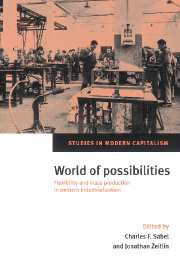Book contents
- Frontmatter
- Contents
- List of contributors
- Acknowledgments
- Stories, strategies, structures: rethinking historical alternatives to mass production
- Part I The modernity of tradition
- 1 Fashion as flexible production: the strategies of the Lyons silk merchants in the eighteenth century
- 2 The fate of collective manufactures in the industrial world: the silk industries of Lyons and London, 1800–1850
- 3 The rise and decline of flexible production: the cutlery industry of Solingen since the eighteenth century
- 4 Manufacturing flexibility in nineteenth-century Switzerland: social and institutional foundations of decline and revival in calico-printing and watchmaking
- Part II The battle of the systems
- Part III The resurgence of flexible production
- Index
1 - Fashion as flexible production: the strategies of the Lyons silk merchants in the eighteenth century
Published online by Cambridge University Press: 12 December 2009
- Frontmatter
- Contents
- List of contributors
- Acknowledgments
- Stories, strategies, structures: rethinking historical alternatives to mass production
- Part I The modernity of tradition
- 1 Fashion as flexible production: the strategies of the Lyons silk merchants in the eighteenth century
- 2 The fate of collective manufactures in the industrial world: the silk industries of Lyons and London, 1800–1850
- 3 The rise and decline of flexible production: the cutlery industry of Solingen since the eighteenth century
- 4 Manufacturing flexibility in nineteenth-century Switzerland: social and institutional foundations of decline and revival in calico-printing and watchmaking
- Part II The battle of the systems
- Part III The resurgence of flexible production
- Index
Summary
Historians of the industrial revolution and capitalism have emphasized the importance of mass production, a concept almost invariably associated with a series of related notions such as “low prices,” “modest or inferior quality” and “extensive market.” These notions come together towards the end of the eighteenth century with cotton, which has been recognized as playing a fundamental role in the early phase of the Industrial Revolution in Britain. Competition over prices and the meeting of supply and demand in a free competitive market are the most widely-held conceptual parameters of an interpretative model tied to the categories of classical economics.
To a large extent ignored, or at least underestimated and underused by historians, are the concepts of competition over product quality and differentiation, monopolistic competition, barriers to entry, flexible production, market segmentation and transactions costs. This is due perhaps to the view that these concepts have validity only for contemporary capitalist societies and that they are irrelevant with respect to the economies of the past.
In this chapter I want to show that these concepts can be used to throw light on a variety of phenomena which have hitherto remained obscure and whose importance in terms of the formation of the capitalist market and of entrepreneurial strategies has still to be fully appreciated.
It is within this framework that I will examine silk fabrics and fashion in eighteenth-century Europe. The silk industry is distinctive in the contrasts it offers to the cotton industry. Prices are high rather than low, markets are small rather than extensive.
- Type
- Chapter
- Information
- World of PossibilitiesFlexibility and Mass Production in Western Industrialization, pp. 37 - 74Publisher: Cambridge University PressPrint publication year: 1997
- 28
- Cited by



